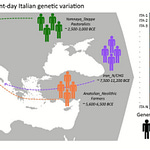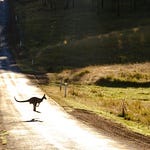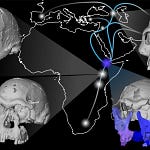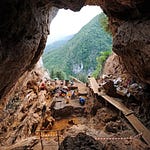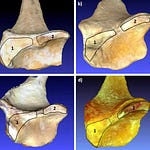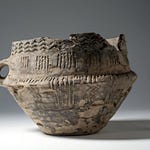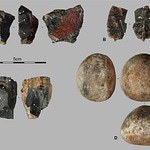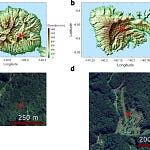Quartz Under Pressure
Around 12,800 years ago, mammoths, mastodons, and saber-toothed cats still roamed North America. Then they vanished. Alongside them disappeared one of the continent’s most recognizable archaeological traditions: the Clovis technocomplex, defined by its fluted spear points and large-scale hunting strategies.
A new study in PLOS One (Kennett et al. 2025) 1 reports quartz grains deformed by pressures and temperatures far beyond what volcanoes or wildfires can produce. The grains come from three sites central to Clovis archaeology: Murray Springs in Arizona, Blackwater Draw in New Mexico, and Arlington Canyon on California’s Channel Islands.
“These three sites were classic in the discovery and documentation of the megafaunal extinctions in North America and the disappearance of the Clovis culture,” explains James Kennett, emeritus professor of Earth Science at UC Santa Barbara.

The team argues that the quartz offers a new proxy for a dramatic event at the Younger Dryas onset — an abrupt return to near ice-age conditions that reshaped ecosystems across the Northern Hemisphere.
Cosmic Airbursts and the Younger Dryas
The Younger Dryas began just as the last glacial period was giving way to a warmer climate. Its onset coincides with both megafaunal extinctions and the disappearance of Clovis technology. Several explanations have been proposed, from meltwater pulses to volcanic activity. Kennett and colleagues point to another culprit: a fragmented comet that exploded over North America.
“All hell broke loose,” Kennett said in earlier remarks about the hypothesis. According to this scenario, low-altitude airbursts sent shock waves and intense heat across the landscape, igniting fires and injecting soot and dust into the atmosphere.
Unlike asteroid strikes that gouge craters into the Earth, airbursts leave few visible scars. But they do leave microscopic ones — etched into minerals like quartz.

Reading the Rocks
Shocked quartz is often called the “smoking gun” of cosmic impacts. Under normal conditions, quartz grains are stable. Under extraordinary pressure, their crystal lattices fracture along distinct planes, sometimes filling with melted silica.
Kennett’s team used electron microscopy and cathodoluminescence to study these grains. They found features consistent with extreme pressures and temperatures, beyond anything known from volcanism or human technology.
“There are going to be some very highly shocked grains and some that will be low-shocked. That’s what you would expect from an airburst rather than a single crater-forming impact,” Kennett noted.
The shocked grains occur in the same sedimentary layer that contains other impact proxies: carbon-rich “black mats,” nanodiamonds, metallic spherules, and meltglass.
Why It Matters for Archaeology
If correct, the findings help explain why the Clovis technocomplex collapsed so suddenly. Airbursts could have destroyed habitats, altered prey availability, and destabilized the societies built around them.
For archaeologists, the discovery underscores the importance of fine-grained geoarchaeological work at classic sites. Microscopic minerals can rewrite narratives built on spear points and mammoth bones.
The study also highlights the global stakes of cosmic events. Similar black mats and impact proxies have been found at sites in Europe and South America, hinting at a hemispheric or even global phenomenon.
Reassessing the End of an Era
The Younger Dryas impact hypothesis remains debated. Critics argue that alternative processes, like wildfires or volcanic eruptions, could produce some of the same proxies. But the shocked quartz adds a new layer of evidence to the puzzle.
Whether by comet or climate, the world of Homo sapiens at the end of the Pleistocene was transformed. The Clovis hunters and the animals they pursued vanished into deep time, leaving behind stones, bones, and now, microscopic scars of a sky that may once have exploded.
Related Research
Bunch, T. E. et al. (2012). “Very high-temperature impact melt products as evidence for cosmic airbursts and impacts 12,900 years ago.” PNAS. https://doi.org/10.1073/pnas.1204453109
Wittke, J. H. et al. (2013). “Evidence for deposition of 10 million tonnes of impact spherules across four continents 12,800 y ago.” PNAS. https://doi.org/10.1073/pnas.1301760110
Kennett, J. P. et al. (2009). “Impact-related younger Dryas boundary layer.” Science. https://doi.org/10.1126/science.1166197
Moore, C. R. et al. (2021). “Sedimentary proxies for the Younger Dryas impact hypothesis.” Scientific Reports. https://doi.org/10.1038/s41598-021-99373-6
Kennett, J. P., LeCompte, M. A., Moore, C. R., Kletetschka, G., Johnson, J. R., Wolbach, W. S., Mitra, S., Maiorana-Boutilier, A., Adedeji, V., Young, M. D., Witwer, T., Langworthy, K., Razink, J. J., Brogden, V., van Devener, B., Perez, J. P., Polson, R., & West, A. (2025). Shocked quartz at the Younger Dryas onset (12.8 ka) supports cosmic airbursts/impacts contributing to North American megafaunal extinctions and collapse of the Clovis technocomplex. PloS One, 20(9), e0319840. https://doi.org/10.1371/journal.pone.0319840


